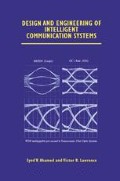Abstract
Microcomputer-based simulation facilities, built to investigate the performance of bandwidth efficient quadrature amplitude modulation (QAM) type 2-dimensional codes, may be used to investigate the capacity of loop plants. Modulating techniques at baseband frequency are the QAM type, 2-dimensional (2-D) carrierless amplitude and phase or CAP modulation. There is no RF carrier (generally associated with QAM) per se in CAP. The CAP techniques are specifically important in the maximum utilization of available bandwidth. Data rates in copper media can thus be maximized to the full media capacity. In particular, these codes are likely to enhance the bidirectional data rates to T1 (1.544 Mbps in the United States) and to E1 (2.048 Mbps in Europe) in the subscriber loop plants. The extent and limitations are discussed in this Chapter. The feasibility of providing Basic Rate Integrated Services Digital Services (BRISDN at 144 kbps) in the various telephone environments is well documented with the 2B1Q code and is used as a benchmark (see Section 9.7.1) for the success or failure of the other more efficient modulating techniques.
Access this chapter
Tax calculation will be finalised at checkout
Purchases are for personal use only
Preview
Unable to display preview. Download preview PDF.
References
G.S. Moschytz and S.V. Ahamed 1991, “Transhybrid Loss with RC Balance Circuits for Primary Rate ISDN Transmission Systems”, IEEE Journal on Selected Areas in Communications, Vol. 9, No. 6, 951–959
G.S. Moschytz and S.V. Ahamed 1991, “Optimization of the RC Matching Network in Adaptive Active Hybrids for High Speed Data Communications”, Proceedings of the IEEE International Symposium on Circuits and Systems, Singapore, June, 2741–2744
J.J. Werner 1991, “The HDSL Environment”, IEEE Journal on Selected Areas in Communications, Vol. 9, 785–800
M. Sorbara, J.J. Werner, and N.A. Zervos 1990, “Carrierless AM/PM”, Contribution T1E1. 4/90–154, September
M.J. Miller and S.V. Ahamed 1988, Digital Transmission Systems and Networks, Volume II: Applications, Computer Science Press, Rockville, MD.
A. Elrefaie, M. Romeiser 1986, “Computer Simulation of Single-mode Fiber Systems”, Conference Record, Optical Fiber Communications Conference, February, 54–56
M. Fashano, A.L. Strodtbeck 1984, “Communication System Simulation and Analysis with SYSTID”, IEEE Journal of Selected Areas in Communications, Vol. J-SAC-2, January, 8–28
K.S. Shanmugan, et.al. 1985, “Simulation of Digital Lightwave Communication Links Using SYSTID”, Record of Globecom 85, December
Author information
Authors and Affiliations
Rights and permissions
Copyright information
© 1997 Springer Science+Business Media New York
About this chapter
Cite this chapter
Ahamed, S.V., Lawrence, V.B. (1997). Simulation Techniques for The QAM (2D) Code. In: Design and Engineering of Intelligent Communication Systems. Springer, Boston, MA. https://doi.org/10.1007/978-1-4615-6291-7_9
Download citation
DOI: https://doi.org/10.1007/978-1-4615-6291-7_9
Publisher Name: Springer, Boston, MA
Print ISBN: 978-1-4613-7888-4
Online ISBN: 978-1-4615-6291-7
eBook Packages: Springer Book Archive

